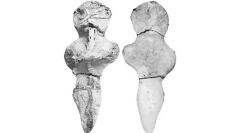

 Comptes Rendus Palevol
9 (6-7) - Pages 283-287
Comptes Rendus Palevol
9 (6-7) - Pages 283-287We describe the manual and digital methods used to prepare an exceptional fossil specimen, as well as the composition of this specimen revealed by these methods. The fossil, a rhinobatoid, is 3-dimensionally preserved in a concretion. Fossils like these are seldom encountered, because flat-bodied animals are traditionally preserved in lithographic beds, or more commonly, are only represented by disassociated dentition. Manual preparation was best conducted with needles and a local application of buffered formic acid and neutralised sodium carbonate. High-resolution computed tomography and post-analysis using the invert ramp option in VGStudio Max 2.0 produced the best results to see the complete skeleton of this specimen. The specimen is distinguishable from the only other known 3D preserved fossil rhinobatoid, the Lower Cretaceous (Albian) genus †Iansan , and is probably a member of Platyrhinidae.
Concretion, Computed tomography, Batoid, Formic acid, Cretaceous, Morocco